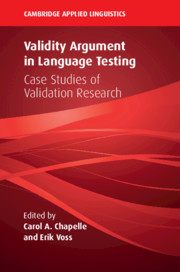Book contents
- Validity Argument in Language Testing
- The Cambridge Applied Linguistics Series
- Validity Argument in Language Testing
- Copyright page
- Contents
- Figures
- Tables
- Contributors
- Series Editor’s Preface
- 1 Introduction to Validity Argument in Language Testing and Assessment
- Part I Basic Concepts and Uses of Validity Argument in Language Testing and Assessment
- 2 Understanding Argument-Based Validity in Language Testing
- 3 A Systematic Review of Argument-Based Validation Studies in the Field of Language Testing (2000–2018)
- Part II Investigating Score Interpretations
- Part III Investigating Score Uses and Consequences
- Part IV Conclusion
- Index
- References
2 - Understanding Argument-Based Validity in Language Testing
from Part I - Basic Concepts and Uses of Validity Argument in Language Testing and Assessment
Published online by Cambridge University Press: 14 January 2021
- Validity Argument in Language Testing
- The Cambridge Applied Linguistics Series
- Validity Argument in Language Testing
- Copyright page
- Contents
- Figures
- Tables
- Contributors
- Series Editor’s Preface
- 1 Introduction to Validity Argument in Language Testing and Assessment
- Part I Basic Concepts and Uses of Validity Argument in Language Testing and Assessment
- 2 Understanding Argument-Based Validity in Language Testing
- 3 A Systematic Review of Argument-Based Validation Studies in the Field of Language Testing (2000–2018)
- Part II Investigating Score Interpretations
- Part III Investigating Score Uses and Consequences
- Part IV Conclusion
- Index
- References
Summary
Argument-based validity has evolved in response to the needs of language testing researchers for a systematic approach to investigating validity of the language tests. Based on a collection of 51 recent books, articles, and research reports in language assessment, this chapter describes the fundamental characteristics of an argument-based approach to validity, which has been operationalized in various ways in language assessment. These characteristics demonstrate how argument-based validity operationalizes the ideals for validation presented by Messick (1989) and accepted by most language testers: that a validity argument should be unitary, but multifacted means for integrating a variety of evidence in an ongoing validation process. The chapter describes how validity arguments serve the multiple functions that language testers demand of their validation tools, and takes into account the concepts that are important in language testing. It distinguishes between two formulations of argument-based validity that appear in language testing to introduce the conventions used throughout the papers in the volume.
Keywords
- Type
- Chapter
- Information
- Validity Argument in Language TestingCase Studies of Validation Research, pp. 19 - 44Publisher: Cambridge University PressPrint publication year: 2021
References
- 7
- Cited by

